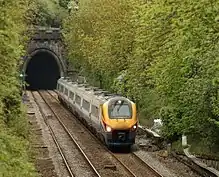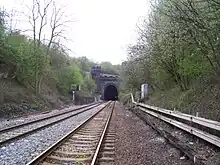 An East Midlands Trains Meridian service leaving the tunnel | |
| Overview | |
|---|---|
| Line | Midland Main Line |
| Location | Clay Cross, Derbyshire |
| Coordinates | 53°09′49″N 1°24′55″W / 53.16359°N 1.41514°W |
| Operation | |
| Work begun | 2 February 1837 |
| Opened | 18 December 1839 |
| Owner | Network Rail |
| Technical | |
| Design engineer | George Stephenson |
| Length | 1,784 yards (1,631 m) |
| Track gauge | 1,435 mm (4 ft 8+1⁄2 in) standard gauge |

Clay Cross Tunnel is a 1,784 yards (1,631 m) tunnel on the former North Midland Railway line near Clay Cross in Derbyshire, England,[1] now part of the Midland Main Line.
Construction
It was designed by George Stephenson with an estimate of £96,000 for construction. The tenders for the work were issued by the North Midland Railway in December 1836.[2] The contractors appointed were Messrs. Hardy, Copeland and Cropper of Watford for the sum of £105,400[3] (equivalent to £10,190,000 in 2021).[4] The tunnel was to be 29 feet (8.8 m) wide and 25 feet 11 inches (7.90 m) high with a bed of broken stone at the base 4 feet (1.2 m) deep to form the rail bed. The tunnel was to be arched completely round with brickwork laid in Roman cement 18 inches (46 cm) deep in the roof and walls, and 14 inches (36 cm) deep in the floor. Approximately 15 million bricks were required for the tunnel lining. The greatest depth below the surface was about 48 yards (44 m).
Construction began on 2 February 1837 when the first sod was turned for the sinking of the ventilation shaft in the centre of the tunnel. The boring of the tunnel was not straightforward, eventually costing £140,000 (equivalent to £13,110,000 in 2021),[4] instead of the expected £98,000 (equivalent to £9,170,000 in 2021),[4] with the loss of fifteen lives.
It was reported in August 1839[5] that the tunnel excavation was completed, and the last brick was expected to be laid within a few days, but in fact was not completed until 18 December 1839.[6]
Description
It begins at the former Derbyshire summit of the line, also the highest point of the whole line, just after the old Stretton railway station. Situated at the watershed of the rivers Amber and Rother. Clay Cross is directly above it and there are ventilation shafts in Market Street (around which the council have placed seats) and High Street (some 150 feet (46 m) above the line).
Until the building of the tunnel, no deep prospecting for minerals had been carried out. The discovery of coal and iron led to George Stephenson moving to Tapton House, near Chesterfield. With a group of others, he bought a tract of land north of the tunnel and set up a company, George Stephenson and Co., later renamed the Clay Cross Company.
The northern portal is a magnificent Moorish design and is now Grade II listed.[7] The south portal is also Grade II listed[8]
Clay Cross railway station was at the northern end, where the line was met by that from the Erewash Valley.
The tunnel saw one of the first uses of the absolute block signalling system, maybe after a narrow escape on the south bound inaugural run. The train was heavier than expected and a pilot engine was provided at the rear. This was detached at the entrance to the tunnel, but halfway through the train came to a halt, and someone had to walk back for the pilot, to the consternation of the passengers. Stephenson had been shown the system by its inventor William Fothergill Cooke supported by Wheatstone of the Wheatstone bridge fame. This was the forerunner of the Midland Railway's system.
See also
References
- ↑ Labrum, Edward A (1994). Civil Engineering Heritage. Eastern and Central England. Thomas Telford House, 1 Heron Quay, London E14 4JD: Thomas Telford Ltd (for the Institution of Civil Engineers). p. 24. ISBN 072771970X.
{{cite book}}: CS1 maint: location (link) - ↑ "North Midland Railway. Contracts for Works". Leeds Mercury. England. 31 December 1836. Retrieved 29 October 2017 – via British Newspaper Archive.
- ↑ "North Midland Railway". Leicester Chronicle. England. 4 February 1837. Retrieved 29 October 2017 – via British Newspaper Archive.
- 1 2 3 UK Retail Price Index inflation figures are based on data from Clark, Gregory (2017). "The Annual RPI and Average Earnings for Britain, 1209 to Present (New Series)". MeasuringWorth. Retrieved 11 June 2022.
- ↑ "Clay Cross Tunnel". Derbyshire Courier. England. 24 August 1839. Retrieved 29 October 2017 – via British Newspaper Archive.
- ↑ Williams, Cliff (1984). Driving the Clay Cross Tunnel. Cromford, Derbyshire: Scarthin Books. p. 76. ISBN 090775807X.
- ↑ Historic England, "North Portal to Clay Cross Railway Tunnel (1087810)", National Heritage List for England, retrieved 29 October 2017
- ↑ Historic England, "Clay Cross Tunnel South Portal (SPC8 68P1) (1417699)", National Heritage List for England, retrieved 29 October 2017
Sources
- Binxton, B (2000). North Midland: Portrait of a Famous Route. Cheltenham: Runpast Publishing.
- The North Midland Railway Guide. Leeds: Turntable Enterprise (republished 1973). 1842.